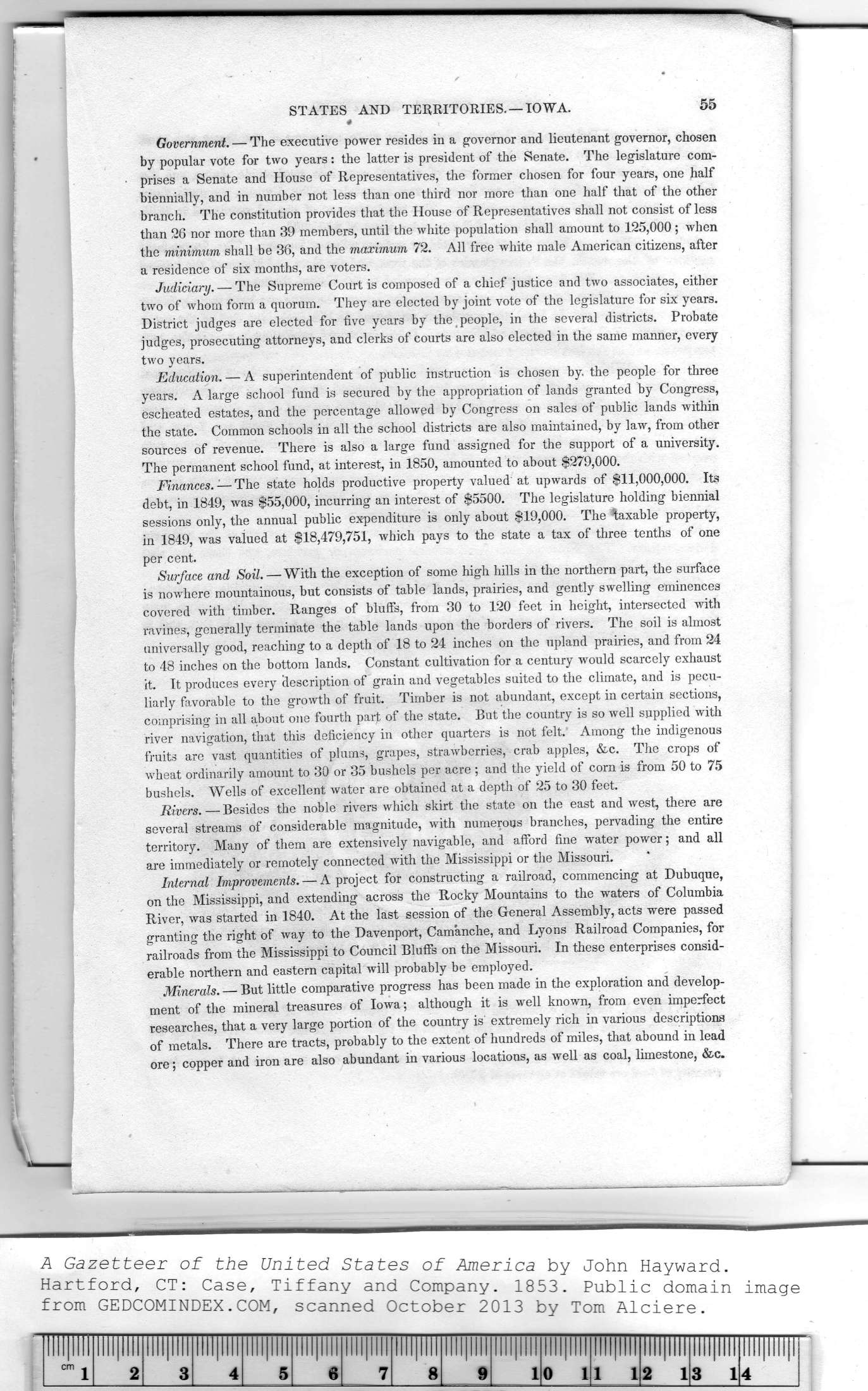|
|
Note: Ctrl and + increases the font size of the text below, Ctrl and - decreases it, and Ctrl and 0 resets it to default size.
STATES AND TERRITORIES. — IOWA. 55
*
Government. — The executive power resides in a governor and lieutenant governor, chosen
by popular vote for two years : the latter is president of the Senate. The legislature com-
prises a Senate and House of Representatives, the former chosen for four years, one half
biennially, and in number not less than one third nor more than one half that of the other
branch. The constitution provides that the House of Representatives shall not consist of less
than 26 nor more than 39 members, until the white population shall amount to 125,000 ; when
the minimum shall be 36, and the maximum 72. All free white male American citizens, after
a residence of six months, are voters.
Judiciary. — The Supreme Court is composed of a chief justice and two associates, either
two of whom form a quorum. They are elected by joint vote of the legislature for six years.
District judges are elected for five years by the people, in the several districts. Probate
judges, prosecuting attorneys, and clerks of courts are also elected in the same manner, every
two years.
Education. — A superintendent of public instruction is chosen by. the people for three
years. A large school fund is secured by the appropriation of lands granted by Congress,
escheated estates, and the percentage allowed by Congress on sales of public lands within
the state. Common schools in all the school districts are also maintained, by law, from other
sources of revenue. There is also a large fund assigned for the support of a university.
The permanent school fund, at interest, in 1850, amounted to about $279,000.
Finances. — The state holds productive property valued at upwards of $11,000,000. Its
debt, in 1849, was $55,000, incurring an interest of $5500. The legislature holding biennial
sessions only, the annual public expenditure is only about $19,000. The 'taxable property,
in 1849, was valued at $18,479,751, which pays to the state a tax of three tenths of one
per cent.
Surface and Soil. — With the exception of some high hills in the northern part, the surface
is nowhere mountainous, but consists of table lands, prairies, and gently swelling eminences
covered with timber. Ranges of bluffs, from 30 to 120 feet in height, intersected with
ravines, generally terminate the table lands upon the borders of rivers. The soil is almost
universally good, reaching to a depth of 18 to 24 inches on the upland prairies, and from 24
to 48 inches on the bottom lands. Constant cultivation for a century would scarcely exhaust
it. It produces every description of grain and vegetables suited to the climate, and is pecu-
liarly favorable to the growth of fruit. Timber is not abundant, except in certain sections,
comprising in all about one fourth part of the state. But the country is so well supplied with
river navigation, that this deficiency in other quarters is not felt. Among the indigenous
fruits are vast quantities of plums, grapes, strawberries, crab apples, &c. The crops of
wheat ordinarily amount to 30 or 35 bushels per acre ; and the yield of corn is from 50 to 75
bushels. Wells of excellent water are obtained at a depth of 25 to 30 feet.
Rivers. — Besides the noble rivers which skirt the state on the east and west, there are
several streams of considerable magnitude, with numerous branches, pervading the entire
territory. Many of them are extensively navigable, and afford fine water power; and all
are immediately or remotely connected with the Mississippi or the Missouri.
Internal Improvements. — A project for constructing a railroad, commencing at Dubuque,
on the Mississippi, and extending across the Rocky Mountains to the waters of Columbia
River, was started in 1840. At the last session of the General Assembly, acts were passed
granting the right of way to the Davenport, Camanche, and Lyons Railroad Companies, for
railroads from the Mississippi to Council Bluffs on the Missouri. In these enterprises consid-
erable northern and eastern capital will probably be employed.
Minerals. — But little comparative progress has been made in the exploration and develop-
ment of the mineral treasures of Iowa; although it is well known, from even imperfect
researches, that a very large portion of the country is extremely rich in various descriptions
of metals. There are tracts, probably to the extent of hundreds of miles, that abound in lead
ore; copper and iron are also abundant in various locations, as well as coal, limestone, &c.
|
lllllllll |
lllllllll |
lllllllll |
lllllllll |
lllllllll |
lllllllll |
lllllllll |
lllllllll |
llll|llll |
lllllllll |
lllllllll |
lllllllll |
lllllllll |
lllllllll |
ll!l|lll!|l |
|
cni j |
2 |
3 |
4 |
5 |
6 |
7 |
8 |
9 |
1 |
0 1 |
1 1 |
2 1 |
3 1 |
4 |
|
